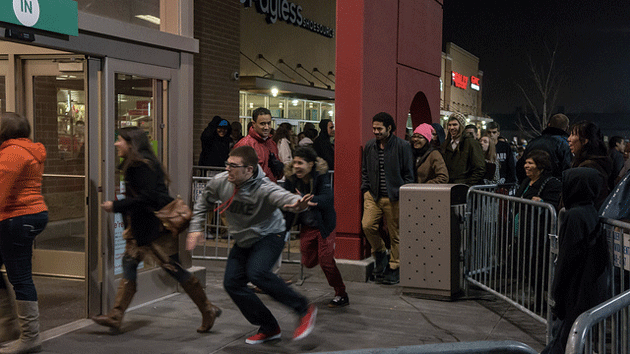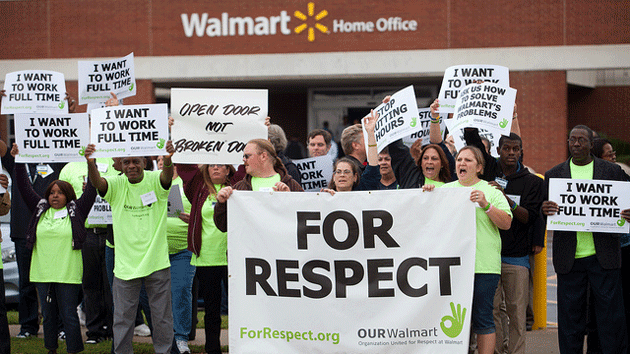
<a href="https://www.flickr.com/photos/hubbardcoe/11224183416/in/faves-88589852@N00/">Powhusku</a>/Flickr
Over the past five years, Black Friday has migrated steadily into Thanksgiving, with each new year bringing fresh examples of big box stores flinging their doors open on Turkey Day. But this year the trend hit the skids. Though Walmart and the other usual suspects will still open on Thanksgiving Day, many big retailers—Costco, Nordstrom, Marshalls, and Home Depot, for example—are holding the line. Outdoor superstore REI went even further, announcing that it will be closed not only on Thanksgiving, but all the way through Black Friday.
Are consumers finally starting to get fed up with the holiday shopping hype? And what motivates some stores to close on Thanksgiving even as others rake in the cash? To find out, I called up Curt Munk, a veteran advisor for big-box retailers and Chief Strategist for the renowned brand agency FCB Red.
Mother Jones: What’s with these stores opening on Thanksgiving?
Curt Munk: Obviously, big-box stores are interested in creating momentum around the holiday. And if you can create that momentum 18 hours earlier in the holiday season, then even if people don’t buy things on Thanksgiving, it kind of plants the seed of, “Oh, I saw that product,” or “I may go back and get it later.” So anytime you can get traffic with motivated, excited consumers, that’s never a bad thing.
MJ: Well, it has prompted a fair amount of criticism from people who want to maintain the integrity of the holiday.
CM: The cultural question is: Is Thanksgiving the day to do that? We do know, based on behavior, that there is pent-up demand. You can only eat so much turkey and watch so much football and stand your in-laws for so long. You almost need a little bit of a break from that. And retail is a great excuse, particularly if you can get a deal. This is about a cultural pendulum, but there are still millions of people out there who want the excitement of the deal and the opportunity to get a leg up on their holiday shopping. If retailers can help them with the process, the more power to ’em.
MJ: I suspect there’s a big difference between what people say they want on Thanksgiving and how they actually behave.
CM: Something like 90 percent of average consumers who are polled say they have absolutely no intention of shopping on Black Friday. But the reality is that something like 38 percent of adult consumers end up going out on that day. Which means that there’s this socially acceptable way of saying, “There’s absolutely no way I’m going to do that but, “Hey, do you want to go out on Thursday or Friday morning? Yeah, I’ll go. I’ll go get a TV, but then I’m coming home.” So it has kind of become this cultural thing, and I think that’s good for the industry and it’s probably fun for consumers. It’s in our best interest in this business to kind of maintain excitement in a peaceful, rewarding way for people that doesn’t punish them.
MJ: Some pretty big retailers are bucking the trend, though. Especially REI. What’s going on there?
CM: REI is planting a stake in the ground, saying, “Not only are we fans of nature; we’re fans of the people who are fans of nature, and as a result we are going to defy convention and allow you to go out and experience nature in a way that only you can participate in.” That kind of focusing on something that is greater than just the traditional noise around the season we think is compelling. That’s something REI can say, because they are not a traditional Black Friday retailer in terms of “stack it high and watch it fly.” What are they going to do, put $85 Patagonia sweaters on pallets on the floor? That’s just not their model. So they are probably sacrificing less in terms of sales than a big box would. The benefits they are gaining in terms of brand personality and support of a point of view is probably much more valuable, long term.
MJ: What about retailers such as Costco and Nordstrom that have decided to stay shut on Thanksgiving Day. What’s in it for them?
CM: Nordstrom and Costco tend to have pretty well-heeled consumers that might be doing other things they value more than getting a television for 15 percent off. There are also operational issues: The economies of scale for heating 80,000 square feet for six hours is very different than doing it for 12. But a lot of it has to do with brands acknowledging that this is an important date for their employees to be with their families.
MJ: Do you think they are doing it more for employee relations, or for PR?
CM: Most retailers are doing it as a favor for their employees.
MJ: But sometimes businesses and labor considerations do overlap.
CM: Right. One of my favorite retail examples is B&H Photo in New York City. They close and don’t even take online orders on Jewish holidays. That’s an extreme example, but B&H has been incredibly firm on their point of view of taking care of their people and honoring those holidays. And you can’t help but respect them for that. It’s one of the things that attracts a good number of people to their brand.
MJ: So what will be the trend going forward?
CM: If people want to shop on that day, I think retailers are going to have to do it. Now it could be in 10 years it moves back to more of a family holiday. That’s entirely likely. REI could start a trend. For specialty stores that have a point of view and a cause to support, why not? If I was REI or Ben & Jerry’s or any of those brands that could take a position on this—like “spend time with your family, come shop with us but do it on Saturday”—I’d probably do it too. But my guess is that will never take with mass retailers because they need that day so much.
MJ: How much of this is just change for its own sake?
CM: I think that’s a big part of it. Everyone is looking for distinction in the marketplace. You may recall a year or so ago when Maker’s Mark did that incredibly important thing, where they said, “Hey, we are selling so much Maker’s Mark that we are reducing the alcohol content from 45 to 43 percent.” And people lost their minds, right? There was that huge speculation about [the motives of Jim] Beam: Was that a marketing ploy or a supply chain problem? In the end, it doesn’t really matter what it was. It gave people something to talk about. And what did that do for Maker’s Mark sales? They shot through the roof.
MJ: How do stores create a frenzy around these sales yet keep things from getting out of control?
CM: There have been some famous incidents at Walmart over the last couple of years where there’s been a kind of stampede. I think reducing the pressure on that 5 a.m. or 6 a.m. opening on Black Friday could be one of the reasons retailers are trying to crack the doors on Thanksgiving. What a lot of retailers have started to do is release sales and specials throughout the day.
I used to work for a larger retail client that used to say that by 10 a.m. on Black Friday the store was essentially empty. Everyone had streamed in between 6:00 and 8:30 and picked the store clean of bargains. It was just normal operating from then on. And that’s not what retailers want. They want to meter that out in such a way that it creates a civilized shopping experience. It’s not good for anyone’s brand to see people fighting over televisions before the sun’s up.”
MJ: Aren’t people in the future just going to get on their computers and order everything and be done?
CM: Absolutely not. You can’t replace the excitement of that treasure hunt and that Turkish-bazaar feel and the immediate gratification. Amazon is trying to do their best to create their own immediate gratification, and my God, they are really good at it. But brands like REI are really good at providing an in-store experience that you can’t really duplicate online.
MJ: Where do you personally come down on these debates about holiday shopping?
CM: I view this as a really good testament to all of the benefits of capitalism. It’s causing people to enjoy brands and to enjoy experiences in new ways, and I like that. It’s fun—probably because I’ve devoted most of my working career to it, so I have to say that!
MJ: But there are these conflicting values at play: tradition and family and workers rights versus convenience and bargains. You really see that a lot over the holidays.
CM: Yeah, and I think you can’t deny the generational differences either. I am very much a mature X-er, and I think about the way my parents viewed the holidays, the way I view the holidays, and then the way my Millennial co-workers experience the holidays. There’s a sense that Millennials can experience holiday shopping, shut that off, and then switch over into enjoying family and their “friends-giving” in a way no one ever could before. They feel like they can compartmentalize it all.
It feels like those of us who are a bit older are the ones having this conversation. If you want to know where this is headed from kind of a cultural and societal standpoint, not to mention an economic one, look at what Millennials are going to do this Thanksgiving. If the social-media behavior around REI’s decision is “Go REI! We’re behind you! Oh by the way, what time do you open Saturday morning?”—then I think we have our answer.
















